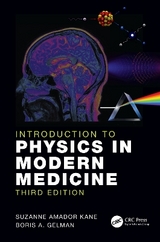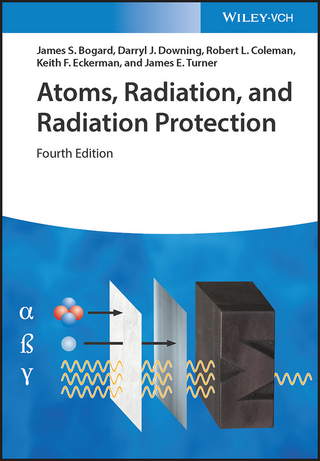
Introduction to Physics in Modern Medicine
Taylor & Francis Inc (Verlag)
978-1-58488-943-4 (ISBN)
- Titel erscheint in neuer Auflage
- Artikel merken
From x-rays to lasers to magnetic resonance imaging, developments in basic physics research have been transformed into medical technologies for imaging, surgery and therapy at an ever accelerating pace. Physics has joined with genetics and molecular biology to define much of what is modern in modern medicine.
Covering a wide range of applications, Introduction to Physics in Modern Medicine, Second Edition builds on the bestselling original. Based on a course taught by the author, the book provides medical personnel and students with an exploration of the physics-related applications found in state-of-the-art medical centers.
Requiring no previous acquaintance with physics, biology, or chemistry and keeping mathematics to a minimum, the application-dedicated chapters adhere to simple and self-contained qualitative explanations that make use of examples and illustrations. With an enhanced emphasis on digital imaging and computers in medicine, the text gives readers a fundamental understanding of the practical application of each concept and the basic science behind it.
This book provides medical students with an excellent introduction to how physics is applied in medicine, while also providing students in physics with an introduction to medical physics. Each chapter includes worked examples and a complete list of problems and questions.
That so much of the technology discussed in this book was the stuff of dreams just a few years ago, makes this book as fascinating as it is practical, both for those in medicine as well as those in physics who might one day discover that the project they are working on is basis for the next great medical application.
This edition:
Covers hybrid scanners for cancer imaging and the interplay of molecular medicine with imaging technologies such as MRI, CT and PET
Looks at camera pills that can film from the inside upon swallowing and advances in robotic surgery devices
Explores Intensity-Modulated Radiation Therapy, proton therapy, and other new forms of cancer treatment
Reflects on the use of imaging technologies in developing countries
Suzanne Amador Kane is a professor of physics and astronomy at Haverford College in Pennsylvania. Her research interests lie at the interface of soft condensed matter physics and biophysics, including biologically-inspired nanostructures, model membrane systems, self-assembly, liquid crystals and artificial evolution.
Introduction and Overview
Telescopes for Inner Space
Optics: the science of light
Fiber optics applications in medicine: endoscopes and laparoscopes
Robotic surgery and virtual reality in the operating room
Telemedicine and military applications
Lasers in Medicine
What is a laser?
More on the science of light: beyond the rainbow
How lasers work
How light interacts with body tissues
Laser beams and spatial coherence
Cooking with light: photocoagulation
Trade-offs in photocoagulation: power density and heat flow
Cutting with light: photovaporization
More power: pulsed lasers
Lasers and color
The atomic origins of absorption
How selective absorption is used in laser surgery
Lasers in dermatology
Laser surgery on the eye
New directions: lasers in dentistry
Advantages and drawbacks of lasers for medicine
New directions: photodynamic therapy—killing tumors with light
New directions: Diffusive optical imaging
Seeing with Sound
Sound waves
What is ultrasound?
Ultrasound and energy
How echoes are formed
How to produce ultrasound
Images from echoes
Ultrasound scanner design
Ultrasound is absorbed by the body
Limitations of ultrasound: image quality and artifacts
How safe is ultrasound imaging?
Obstetrical ultrasound imaging
Echocardiography: ultrasound images of the heart
Origins of the Doppler effect
Using the Doppler effect to measure blood flow
Color flow images
Three-dimensional ultrasound
Portable ultrasound—appropriate technology for the developing world
X-Ray Vision
Diagnostic x-rays: the body’s x-ray shadow
Types of x-ray interactions with matter
Basic issues in x-ray image formation
Contrast media make soft tissues visible on an x-ray
How x-rays are generated
X-ray detectors
Mammography: x-ray screening for breast cancer
Digital radiography
Computed tomography (CT)
Application: spotting brittle bones—bone mineral scans for osteoporosis
Images from Radioactivity
Nuclear physics basics
Radioactivity fades with time: the concept of half-lives
Gamma camera imaging
Emission tomography with radionuclides: SPECT and PET
Application: emission computer tomography studies of the brain
Hybrid scanners
Radiation Therapy and Radiation Safety in Medicine
Measuring radioactivity and radiation
Origins of the biological effects of ionizing radiation
The two regimes of radiation damage: radiation sickness and cancer risk
Radiation therapy: killing tumors with radiation
New directions in radiation therapy
Magnetic Resonance Imaging
The science of magnetism
Nuclear magnetism
Contrast mechanisms for MRI
Listening to spin echoes
How MRI maps the body
How safe is MRI?
Creating better contrast
Sports medicine and MRI
Magnetic resonance breast imaging
Mapping body chemistry with MR spectroscopy
Brain mapping and functional MRI
Each chapter contains an Introduction, Questions, and Problems.
| Erscheint lt. Verlag | 1.5.2009 |
|---|---|
| Zusatzinfo | 8 page color insert follows pg 78; 79 equations; 21 Tables, black and white; 283 Illustrations, black and white |
| Verlagsort | Washington |
| Sprache | englisch |
| Maße | 156 x 234 mm |
| Gewicht | 635 g |
| Themenwelt | Medizin / Pharmazie ► Allgemeines / Lexika |
| Naturwissenschaften ► Physik / Astronomie ► Angewandte Physik | |
| ISBN-10 | 1-58488-943-8 / 1584889438 |
| ISBN-13 | 978-1-58488-943-4 / 9781584889434 |
| Zustand | Neuware |
| Informationen gemäß Produktsicherheitsverordnung (GPSR) | |
| Haben Sie eine Frage zum Produkt? |
aus dem Bereich



